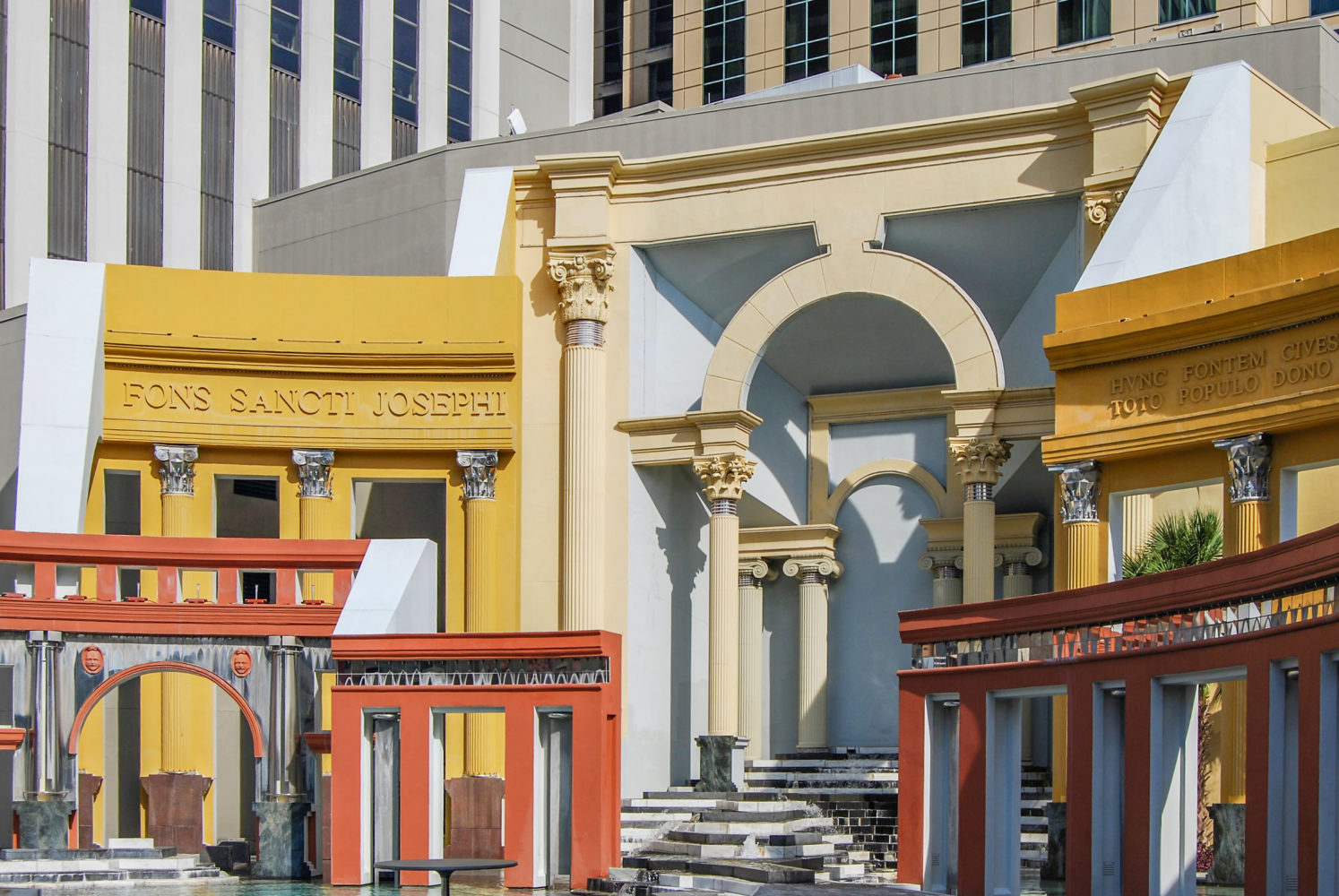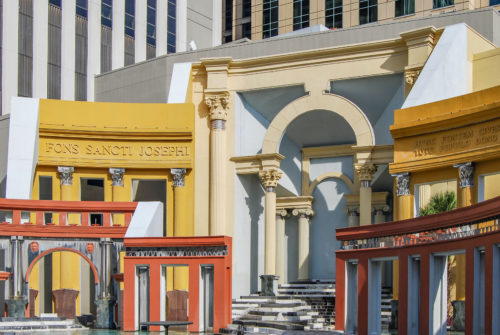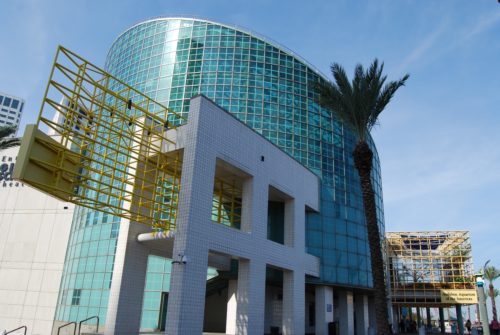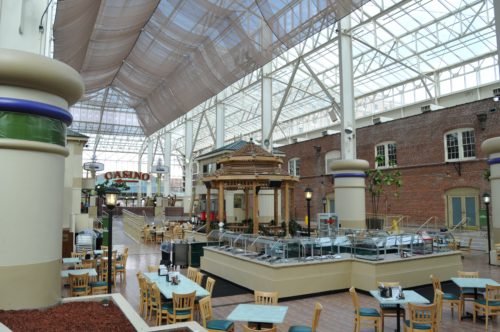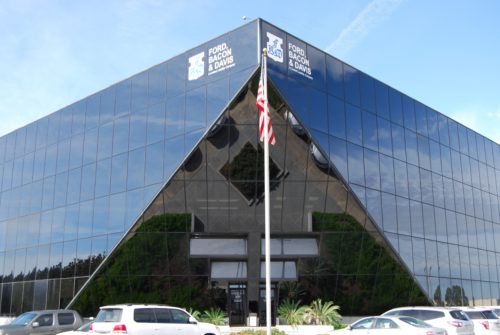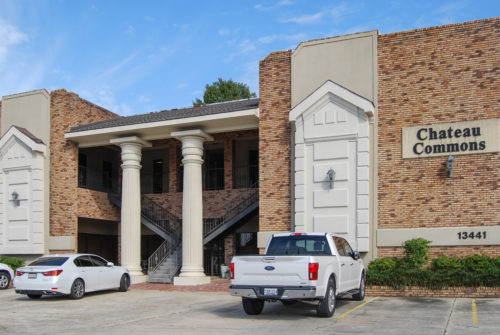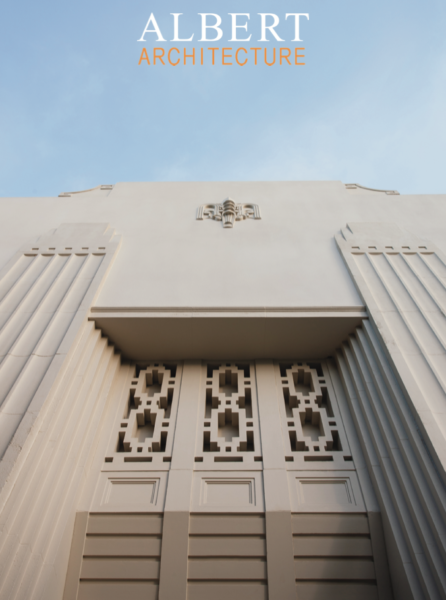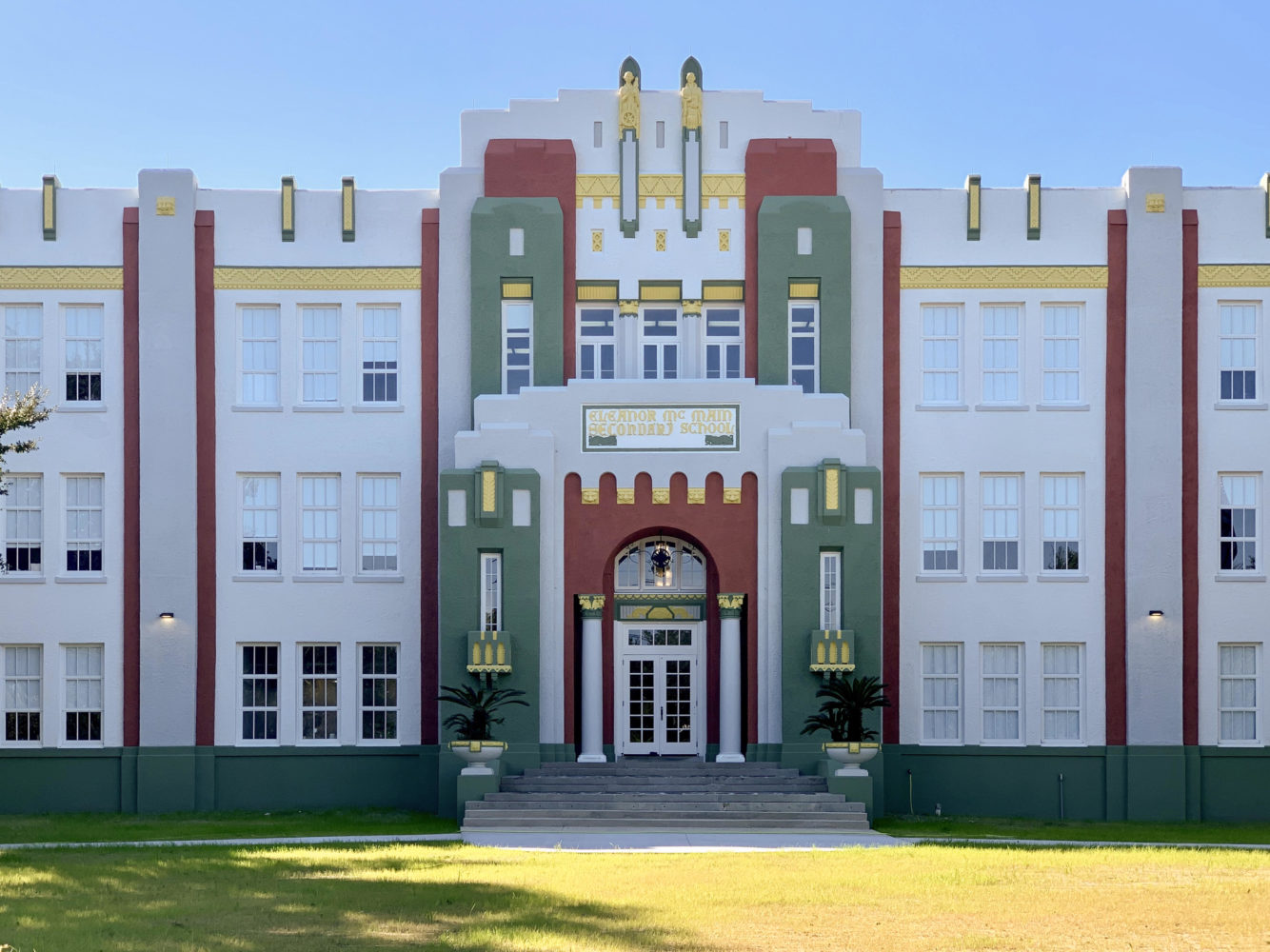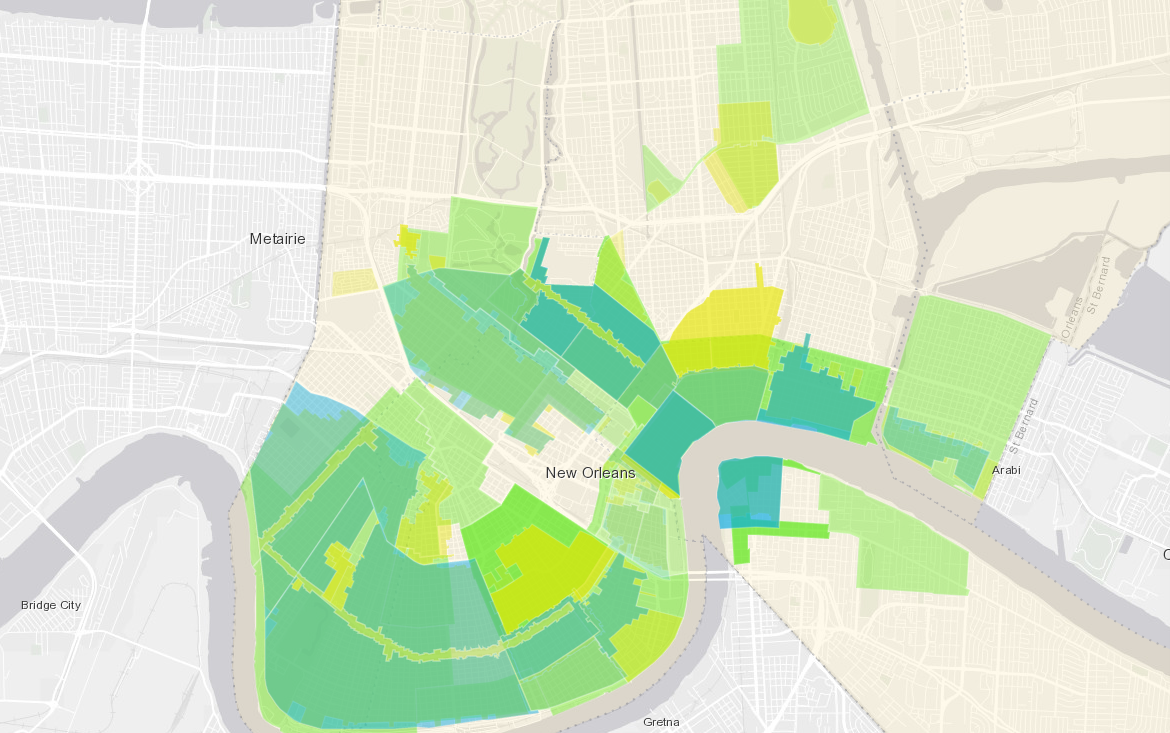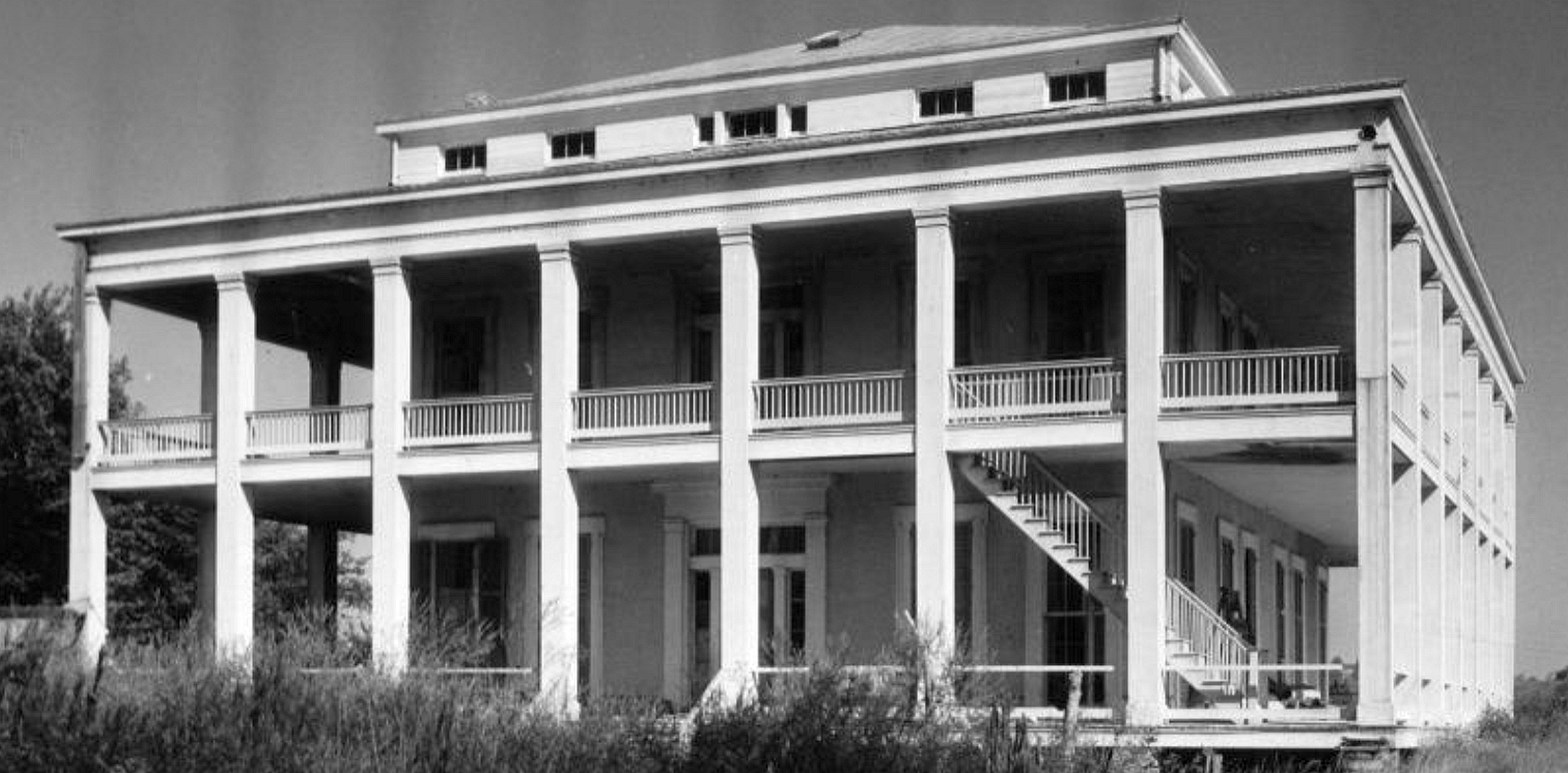This story appeared in the December issue of the PRC’s Preservation in Print magazine. Interested in getting more preservation stories like this delivered to your door monthly? Become a member of the PRC for a subscription!
In the mid- to late 20th century, fashion moved toward skyscraper hair, geometric clothing and accessories, and a new found fascination with eclectic Asian design. Architecture was destined to follow suit.
Postmodern architecture, known affectionately as PoMo, reflects the decadence of the disco-daring 1970s and the “Greed is Good” 1980s and early ’90s. While Mies van der Rohe famously said, “Less is more,” PoMo darling Robert Venturi quipped back, “Less is a bore.”
High-rise buildings with perfect circles cut into enormous, decorative-only pediments began to dominate skylines, and origami-like facades emerged from the landscape in office parks. Postmodernism screamed goodbye to “form follows function” and hello to complexity, contradiction, color and camp.
Elements of PoMo can include exaggerated historical details, such as oversized pediments or decorative cornices; a mixture of historical and modern details, like a broken swan’s neck pediment on a glass curtain wall; and an emphasis on bright colors and mixtures of building materials. The style is far-reaching and hard to define, and it can become a heady blend of styles, forms, materials and scale.
“The battle for the 1980s has just begun.”
—architect and author Alan Hess, speaking at the Preserving the Recent Past 3 conference in Los Angeles, March 13, 2019
What influenced Postmodernism’s popularity in Louisiana? The answer, primarily, is the economy. The economic downturn in the mid-1980s from the collapse of the oil and gas industry led to devastation across south Louisiana, slowing new construction and deferring needed maintenance for many buildings. As a result, urban renewal programs sprang up, with a primary “solution” to blight being demolition.
Growth of the state’s tourism industry and leisure activities eventually offered a positive turn for the economy. From the late 1970s to the 1990s, downtown New Orleans saw a boom in Postmodern construction, from the exuberant Aquarium of the Americas (1990); to Harrah’s, the first (legal) land-based casino in modern Louisiana history; to the Piazza d’Italia (1978), a site intended for festivals, markets and revelry. The Piazza was designed by Charles Moore, a noted Postmodern architect, and Perez Architects, a New Orleans institution.
“The historical allusions and playfulness of the (Piazza’s) ensemble were considered an ultimate expression of Postmodernism,” Karen Kingsley wrote in Buildings of Louisiana. (After a recent renovation, the Piazza reopened in late 2018.)
1: Piazza d’Italia in New Orleans’ Warehouse District. 2: Aquarium of the Americas in New Orleans. Photos by Alison Saunders.
Other notable examples of PoMo can be found across Louisiana, including the Catfish Town redevelopment in Baton Rouge, a meandering complex of historic buildings connected via an overreaching glass atrium that serves as an entertainment venue for an associated river-based casino; the old Southwestern Electric Power Company building in Shreveport, which is defined with a public plaza, public art and a façade that embraces a variety of materials and historic architectural references; and the MRI Center in Alexandria, a tan and red building block confection topped with a U-shaped monitor roof. (A monitor roof is similar to a skylight but with a row of clerestory windows that run along the vertical portions of the structure, usually with a solid material covering.) The end pieces of the U terminate toward the street, giving the entire building a quizzical, lifted eyebrow look.
Like most historic buildings, Postmodern architecture faces the same three major threats: demolition, deferred maintenance and alteration/loss of integrity. However, if folks have found Brutalism a hard sell, seeing the value in PoMo may be incomprehensible. That’s why it is so important to start the work now to save PoMo.
First, we need to connect Postmodernism to popular imagination and nostalgia. Think about the most recent Stranger Things episodes on Netflix, especially the one entitled The Battle of Starcourt, which featured a Postmodern shopping mall that was so exquisitely detailed you could practically smell Debbie Gibson’s Electric Youth perfume.
Nostalgia for the 1980s and ’90s pervades pop culture right now, with television shows, like The Goldbergs and The Americans. There’s even a rebirth of Caboodles, those ubiquitous makeup organizers whose logo of geometric designs could just as easily be seen on top of a building, printed on a jacket, or as the pattern for landscaping elements within an office park.
Besides igniting interest in PoMo through pop culture, we can look back at projects that earned architectural design awards in the 1970s, ’80s and ’90s as excellent examples of these styles that deserve attention today.
1: Catfish Town atrium in Baton Rouge. 2: 12021 Lakeland Park Blvd., Baton Rouge. The chamfered corner cut makes this building distinctly PoMo. 3: Chateau Commons, 13411 Tiger Bend Road, Baton Rouge. This building showcases another distinctive PoMo feature: exaggerated historic details, in this case oversized Doric columns, quoins and paneled reliefs added to an otherwise nondescript brick façade. Photos by Alison Saunders.
The State Historic Preservation Office and its non-profit partners also need your help to find buildings, sites, structures and objects that tell the story of Louisiana from 1945 to 1985 (and even later). One easy way to highlight PoMo architecture is to tag your public social media posts with #LaPreservation, #PoMo and #InspiredToPreserve. If you see a social media post that the Louisiana SHPO should be aware of, don’t hesitate to “at” us:
- Instagram: @Louisiana_hp
- Facebook: Louisiana Office of Cultural Development
- Twitter: @LaStateCulture
Brian Goeken, chief of the National Park Service’s Technical Preservation Services, mentioned to attendees of the Preserving the Recent Past 3 Conference that we “would be surprised by the number of historic tax credit projects coming through [its office] from the 1960s, ’70s and a few even from the 1980s.” Some savvy developers are already nominating significant structures to the National Register of Historic Places, thereby opening the door to the lucrative federal, and in some cases, state historic rehabilitation tax credits. Additional information on listing a building less than 50 years old in the National Register of Historic Places may be found in National Register Bulletin: How to Apply the National Register Criteria for Evaluation.
Let’s encourage the survey of these historic resources now, potentially through a more crowd-sourced approach, like the one used in Houston to survey post-war structures. The Houston: Uncommon Modern project utilized Dropbox, a simple Excel spreadsheet and Google maps to allow for public participation. As the project was wrapping up, tours were organized, an exhibit was created, an exhibition catalog was released, and panel discussions were hosted.
Finally, zoning overlays can create an additional degree of consideration for these buildings, without creating more restrictive local historic districts and commissions. These may prevent unintentional consequences when property owners are simply unaware of the treasures they have.
Postmodernism is the quintessential expression of the exuberance of the 1980s. While it currently may be out of favor, as preservationists, we need to consider what its importance will be in the future. Being responsible stewards and advocates for the “future past,” is, as Bill and Ted would say, “Excellent!”
Tag PoMo
During December, the Louisiana State Historic Preservation Office encourages you to take pictures of your favorite Postmodern buildings. Tag them on social media with #PoMo, #LaPreservation and #InspiredToPreserve, and you will be entered to win a drawing for a new, but very retro-inspired, Caboodles makeup case.
Alison F. Saunders is the Tax Incentives Director for the Louisiana Division of Historic Preservation.
Advertisements




